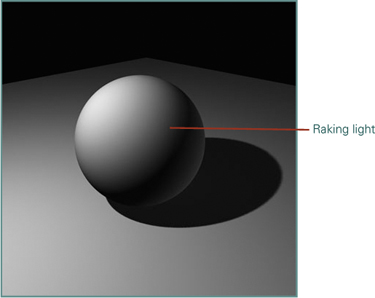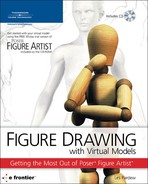Light and Shadow
Where there is light there is also shadow. A shadow is an area of diminished light because the object is blocking some of the light from entering. The light and shadow of an object help show its shape and dimensions. In Figure 7.6, the shadow gives the figure the appearance of standing on the ground, even though the figure is only seen in silhouette.
Figure 7.6. The shadow helps to plant the figure on the ground.

Now let’s take a look at how light defines a three-dimensional object. We will start with a simple shape, such as a sphere. Look at Figure 7.7 and try drawing the picture of a ball sitting on a tabletop before you go on to the rest of the chapter.
Figure 7.7. Draw and shade the sphere.

Highlight
The highlight of an object is the part that light directly reflects from the light source to the viewer’s eyes. The highlight is located on the brightest area of the ball, as shown in Figure 7.8. The highlight area is at a direct reflection angle from the light source. If you are using white paper and a pencil, the highlight will generally be left as the white of the paper. For this reason, you don’t actually draw the highlight; rather, you draw the rest of the object and leave the highlight.
Figure 7.8. The highlight is a direct reflection of the light source.

Raking Light
The area that surrounds the highlight where the light is not as directly reflected is called raking light. The name comes from the way the light skims across the surface and hits it at an angle. This area extends outward from the highlight and gradually gets darker because the surface of the object is turning away from the light, as shown in Figure 7.9.
Figure 7.9. Raking light hits a curved surface at an angle.

Light Area
The area that contains the highlight and the raking light is the light area of an object. Most objects can be defined as having a light area and a shadow area. Because the light area receives the most light, most of the detail in a drawing is in this area. Figure 7.10 shows the light area of the ball.
Figure 7.10. The light area of the ball is the area receiving direct light.

Shadow Area
All of the area that does not receive direct light from the light source is called the shadow area (see Figure 7.11).
Figure 7.11. The shadow area is the area of an object not receiving direct light.

As the surface of the ball turns away from the light source, it no longer receives light directly from the light source. The shadow area generally receives the least amount of detail in a drawing because there is less light to define this area.
In situations where there is only one light shining on an object, such as a ball, roughly half of the ball will be in the shadow area and half will be in the light area. Viewing the ball directly to the side of the light source illustrates how the light and shadow areas are divided, as shown in Figure 7.12.
Figure 7.12. Half the ball is on the light side, and half is on the shadow side.

Core Shadow
There is a band of shadow that separates the raking light from the shadow area of the ball. This shadow is called the core shadow, and it is shown in Figure 7.13.
Figure 7.13. The core shadow runs on the line next to the light side of an object.

The core shadow runs along the edge of the object that is directly past the influence of the light. It is a very important shadow for the artist because the core shadow, more than any other shading, defines the form. The core shadow is the darkest shadow on the ball because it receives the least amount of light.
Reflected Light
The shadow area does not receive direct light from the light source, but it does receive indirect light. Indirect light is reflected from other surfaces onto the ball. In the picture of the ball, the light that hits the table and reflects back to us also reflects back toward the ball. The reflected light gives definition to the shadow area of a drawing, as shown in Figure 7.14.
Figure 7.14. Half the ball is on the light side and half is on the shadow side.

Cast Shadow
Because the ball interrupts some of the light traveling from the light source to the table, there is an area of shadow on the table. This area of shadow is called the cast shadow. It is shown in Figure 7.15.
Figure 7.15. The cast shadow is the area of shadow cast from an object onto another surface.

Cast shadows are not just flat shadows. They have unique characteristics that an artist must understand to make them look correct. As the shadow becomes more distant from the object, the edge becomes less distinct. This happens because there is more chance for reflected light to reach the shadow area. The shadow has a diffused edge, as shown in Figure 7.16.
Figure 7.16. The edge of a shadow is diffused as it goes away from an object.

There is also a slightly lighter area just beneath the ball. This area is the twice-reflected light area. The light that is reflected to the ball bounces off the ball and into the cast shadow area, giving that area a small amount of light, as shown in Figure 7.17. This is one reason why some cast shadows seem to be lighter near the middle.
Figure 7.17. Reflected light also bounces from the ball to the cast shadow.

Front and Rim Lighting
Many artists like to light their scenes with the light coming from behind the artist and to the side so they can show most of the light, but also some of the shadow areas. This type of lighting best defines the form of the objects in their drawings. Lighting from the front or the back of the object tends to flatten the form of the object, as shown here. However, sometimes these types of lighting effects can add drama to a drawing, especially in the case of rim lighting, as shown in Figure 7.18.
Figure 7.18. Front and rim lighting tend to flatten objects.

Multiple Light Sources
Many times, objects we see in life have more than one light source. This is particularly true of characters or objects that are in interior settings. A single room inside a building might have many lights illuminating a character or object from multiple angles. Each light will have an effect on how the character or object looks. This can often be confusing for the artist who has to track the direction of the lights to understand the angles of the lights. The picture in Figure 7.19 shows the ball with three lights. Notice the multiple cast shadows. The cast shadows are the best clue for determining the number and location of all the lights hitting the object.
Figure 7.19. It can sometimes be confusing to draw an object with multiple light sources.

Did you realize there was so much involved in the lighting of a simple ball? We see light every day, but unless we are familiar with its nature, we might miss many aspects. Try drawing the ball again, and this time use what you have just learned about light to define the lighting of the ball. Compare your drawings. Was your second drawing a better depiction of the ball?
We are not done yet. There is still a lot more to learn about light.
